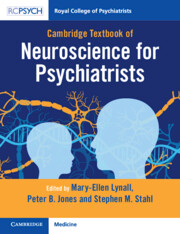Book contents
- Cambridge Textbook Of Neuroscience for Psychiatrists
- Reviews
- Cambridge Textbook of Neuroscience for Psychiatrists
- Copyright page
- Contents
- Contributors
- Introduction
- 1 Cells
- 2 Neurotransmitters and Receptors
- 3 Basic Techniques in Neuroscience
- 4 Neuroanatomy
- 4.1 Fundamentals
- 4.2 The Basal Ganglia
- 4.3 The Temporal Lobes
- 4.4 The Frontal Lobes
- 4.5 White Matter Pathways
- 4.6 Ascending Neurotransmitter Systems
- 5 Neural Circuits
- 6 Modulators
- 7 Genetics
- 8 Neurodevelopment and Neuroplasticity
- 9 Integrated Neurobiology of Specific Syndromes and Treatments
- 10 Neurodegeneration
- Index
- References
4.1 - Fundamentals
from 4 - Neuroanatomy
Published online by Cambridge University Press: 08 November 2023
- Cambridge Textbook Of Neuroscience for Psychiatrists
- Reviews
- Cambridge Textbook of Neuroscience for Psychiatrists
- Copyright page
- Contents
- Contributors
- Introduction
- 1 Cells
- 2 Neurotransmitters and Receptors
- 3 Basic Techniques in Neuroscience
- 4 Neuroanatomy
- 4.1 Fundamentals
- 4.2 The Basal Ganglia
- 4.3 The Temporal Lobes
- 4.4 The Frontal Lobes
- 4.5 White Matter Pathways
- 4.6 Ascending Neurotransmitter Systems
- 5 Neural Circuits
- 6 Modulators
- 7 Genetics
- 8 Neurodevelopment and Neuroplasticity
- 9 Integrated Neurobiology of Specific Syndromes and Treatments
- 10 Neurodegeneration
- Index
- References
Summary
Neuroanatomy is the study of the structure of the nervous system. Starting with an overview of important terminology and the embryological origins of the nervous system, this section describes its basic anatomy at different lellopregnanonisation: macroscopic, microscopic and circuit-level. The fluid compartments within the nervous system are also reviewed.
- Type
- Chapter
- Information
- Cambridge Textbook of Neuroscience for Psychiatrists , pp. 77 - 89Publisher: Cambridge University PressPrint publication year: 2023

